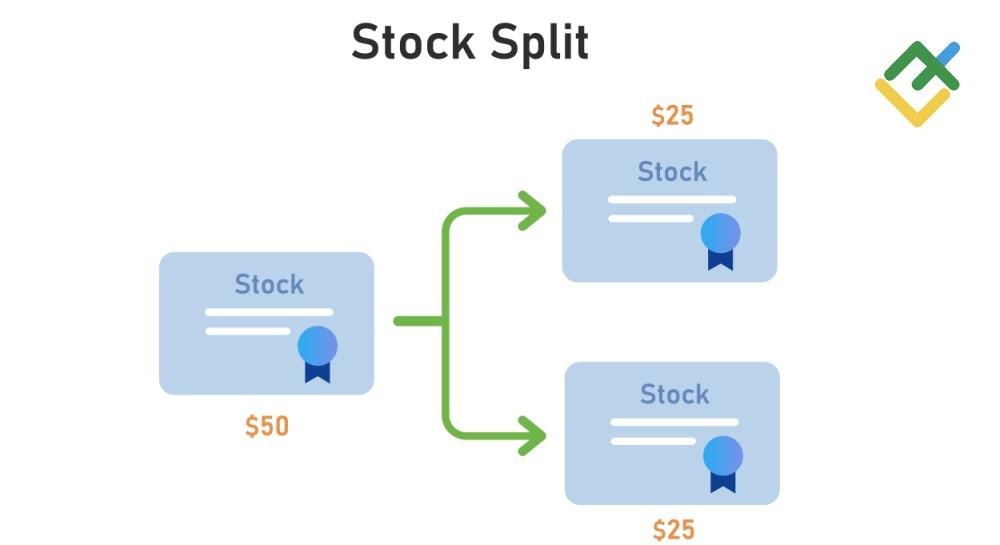
A stock split is a process in which a company increases the number of its outstanding shares, reducing the price of each share without changing a company’s market value. Large publicly traded companies commonly use this corporate action to boost liquidity and attract new investors. However, many novice traders and shareholders wonder what a stock split is and why companies do it.
Answering this question can help you better understand how the stock market works, assess the impact of such events on your portfolio, and choose an effective investment strategy. The article explains what a stock split is, how it works in practice, and what outcomes it can have.
The article covers the following subjects:
Major Takeaways
- A stock split does not affect the market value of a company.
- After a split, the price and number of shares in circulation change, but the investor’s overall ownership stake stays the same.
- The most common types of splits are forward stock splits and reverse stock splits.
- After a split, liquidity and trading volume usually increase.
- A company’s board of directors approves the split and sets the stock split ratio.
- Splits affect dividend yield and earnings per share (EPS) but do not affect the actual payout.
- Apple, Tesla, and Google frequently split their shares, which makes it challenging to perform technical analysis based on their historical data.
What Is a Stock Split?
A stock split is an action a company takes to reduce the value of its shares and increase the number of shares outstanding. This way, the owner’s share remains the same. Companies do this to make their shares more accessible, increase liquidity, and attract a broader range of buyers and sellers. A stock split does not affect a company’s fundamental indicators, but it can raise interest in the asset. The decision to split shares is made by the board of directors and does not require input from shareholders.
How Stock Splits Work: Step-by-Step Process
Remember that a split does not change the overall value of the company. The capitalization remains the same. The number of shares outstanding increases, while the price of each share decreases in proportion to the ratio. For example, if a company carries out a three-for-one split, each share is divided into three shares, and the value of each share is reduced to one-third of its original value.
Investors do not have to participate in this process. All calculations are performed automatically through the broker, and the new securities appear on the investor’s account on a specified date. Thus, stock splits do not affect shareholders’ ownership interests or the value of their portfolios. The main purpose of a split is to enhance the accessibility of an asset and boost its liquidity. By lowering the share price, a company can attract new investors and drive up trading volume on the stock exchange without issuing new shares or diluting ownership.
Types of Stock Splits
Stock splits can take various forms, depending on a company’s goals and market conditions. The most common type is a forward split, where the number of outstanding shares increases and the share price decreases proportionally. Less frequently, companies may carry out a reverse split, which reduces the number of shares while increasing the share price. Although these are the most typical approaches, companies may also choose to implement less conventional or non-standard split ratios.
Forward Stock Split
In a forward stock split, the company increases the total number of shares outstanding and reduces the share price in the same proportion. This strategy is the most common type of stock split, especially among public companies with high share prices. Common splits include 2:1, 3:1, and 4:1 ratios, allowing shareholders to receive two, three, or four times as many shares, respectively.
The main goal is to enhance accessibility of assets for retail investors. As a result of a forward split, shares become more appealing from a psychological standpoint, often leading to positive stock market performance, especially in the short term.
Reverse Stock Split (Consolidation)
A reverse split is when a company reduces the number of its shares outstanding and proportionally increases the price per share. As a result, the number of shares decreases, but their total market value remains unchanged. For example, in a 1:10 reverse split, ten shares worth $10 each are consolidated into one share worth $100.
A reverse split is mostly used when stocks fall to a critically low price. This move lets a company meet the minimum requirements for a stock exchange and avoid being delisted. Although it has no real impact on a company’s performance, investors sometimes view consolidation as a sign of potential problems.
Common Stock Split Ratios
Companies use different stock split ratios depending on their objectives, current share price, and the situation in the stock market. The choice of ratio reflects the company’s strategy and may influence how shareholders perceive the company. A well-chosen stock split ratio can attract new investors and boost the liquidity of an asset.
|
Ratio |
Split Type |
Description |
Purpose |
|
2-for-1 |
Forward split |
Each share is split into two shares |
To enhance accessibility and liquidity |
|
3-for-1 |
Forward split |
Each share is split into three shares |
To expand the investor base |
|
4-for-1 and 10-for-1 |
Forward split |
Each share is split into four/ten shares |
To attract new market participants |
|
1-for-10 |
Reverse split |
10 shares are consolidated into one |
To avoid delisting |
|
1-for-20 |
Reverse split |
20 shares are consolidated into one |
To support the stock price |
Why Do Companies Split Their Stocks?
Many investors question the purpose of a stock split since it doesn’t alter the total value of their holdings. Although a split doesn’t change a company’s overall market capitalization, it can serve several crucial goals.
Firstly, shares priced lower reduce the initial capital barrier for small investors, increasing the number of shareholders.
Secondly, a higher share count after a split spurs liquidity, making it easier to buy and sell securities while also driving up trading volume on the stock exchange.
Thirdly, a company may conduct a stock split to keep investors interested. For example, if shares are priced at $1,000 each, they can appear out of reach for some investors. However, after a split, if the price drops to $100 per share, it becomes more appealing.
In contrast, a reverse split can be a smart move to help a company stay listed on a major exchange. On exchanges like NASDAQ, a share needs to trade above $1. For companies whose stock has plummeted, a reverse split can be a lifeline, helping them avoid delisting and stay publicly traded.
In some cases, companies carry out stock splits as part of broader efforts to get included in major stock indices or to position themselves for an IPO or follow-on offering.
Examples of Stock Splits
In August 2020, Apple (AAPL) executed a four-for-one stock split. Before this, the share price exceeded $500, which limited the number of retail investors. Following the split, shares traded around $125, leading to a surge in trading volumes. This was the fifth split in Apple’s history.
Tesla (TSLA) performed two stock splits: a five-for-one split in 2020 and a three-for-one split in 2022. The initial split took place when the share price surpassed $2,000, while the subsequent split was implemented following an increase in the company’s market capitalization. Both stock splits were met with enthusiasm by private investors.
In July 2022, Alphabet (GOOGL) conducted a 20-to-1 stock split, causing the price to drop from $2,300 to around $115 per share. The goal was to make the stock more accessible to a broader audience and boost liquidity in the market.
In June 2022, Amazon (AMZN) went through a 20-for-1 stock split, lowering its share price from $2,447 to around $124.79. This step attracted a wider pool of investors.
In 2021, NVIDIA (NVDA) implemented a 4-for-1 stock split, reducing the price from $750 to ~$187, which made the company’s shares more affordable to new market participants.
Shopify (SHOP) conducted a 10-to-1 split, Monster Beverage (MNST) executed a 2-to-1 split, and Visa (V) and Mastercard (MA) both carried out 1-to-2 splits. As these examples show, companies use stock splits as a strategic tool rather than a purely technical move.
How Stock Splits Affect Investors
A stock split may seem like a technical adjustment that does not affect a company’s fundamentals. However, its consequences for investors, mutual funds, and existing shareholders can be quite significant. A split changes the share price, increases the number of outstanding shares, and leads to a recalculation of portfolio positions. Thus, understanding the stock split definition is essential for anyone involved in stock trading or fund management.
Impact on Share Ownership
After a stock split, the shareholders’ ownership interest remains the same. If, before the split, an investor held 100 shares out of 10,000 (1%), then after a 2-for-1 split, they will hold 200 shares out of 20,000, which will still represent 1%.
Many investors, especially beginners, may feel uneasy when they see changes in their share holdings. But in reality, a company’s decision to split or consolidate its stock affects only the structure of ownership, not the company’s fundamentals. In the case of a reverse split, the number of shares decreases, but the investor’s ownership stake remains unchanged because the share price rises proportionally.
Note: The broker automatically recalculates the number of shares and their nominal value, so shareholders don't need to take any action. A stock split has no impact on shareholder rights, including voting privileges, dividends, or participation in shareholder meetings.
Effect on Portfolio Value
After a stock split, the total value of an investor’s portfolio will remain as it was. If an investor previously owned one share worth $1,000, after a 10-for-1 split, they will own 10 shares worth $100 each, still totalling $1,000.
Nevertheless, stock splits offer greater flexibility for investors. When share prices are high, it can be difficult to sell just a portion of a position, as shares often need to be sold in whole units or larger blocks. After a split, investors can sell smaller quantities, even just one or two shares, making it far more convenient, especially for individual investors.
Key Dates in Stock Split Process
A stock split process involves several formal stages, each of which is essential for the correct accounting of securities and understanding their movement in the stock market. There are several key dates between the announcement and the actual recalculation of shares.
Announcement Date
The announcement date is the moment when a company’s board of directors officially decides to split its shares and publishes a corresponding announcement. This date is of great importance to investors, as the share price may change immediately after the announcement. Details about the split, including the ratio and anticipated implementation date, are typically shared in a press release or corporate statement.
Record Date
The record date is the day when a company compiles an official list of shareholders who are eligible to receive more shares after the split. All investors who hold securities on this date automatically participate in the split, regardless of whether they purchased the shares long before the announcement or shortly before the record date. This key moment in the split process also affects how mutual funds and fractional shares are adjusted. The broker uses this date as a reference point for recalculating positions in the portfolio.
Note: You need to buy shares for the split in advance, no later than the ex-dividend date.
Ex-Dividend Date
The ex-dividend date, also known as the cut-off date, marks the point after which shareholders are no longer eligible to participate in a stock split. To qualify for a split, investors must purchase shares before this date. Any shares bought after the cut-off date will not be included in the share adjustment. This date plays a crucial role in accurately recording ownership and calculating key metrics such as dividend yield and earnings per share. Misunderstanding how the cut-off date works can result in missed opportunities or even financial losses.
Distribution Date
The distribution date is when the new shares from a stock split are officially credited to investors’ accounts. On this day, the number of shares and their price are automatically adjusted according to the split ratio. These changes are reflected on trading platforms and in broker statements, with no action required from investors. The updated securities become available for trading at the post-split price, and the broker ensures that portfolio positions are displayed correctly. This date marks the final step in the split process and confirms the new parameters of share ownership.
Advantages and Disadvantages of Stock Splits
Although a stock split does not affect a company’s fundamental indicators, it may influence the future actions of investors and traders.
Advantages
The main advantages of stock splitting include greater liquidity. After a split, the share price falls, opening the door to a broader pool of investors. Besides, the increased number of shares allows investors to manage their portfolios more freely, enabling them to sell or buy smaller amounts of shares. In addition, stock splits are often associated with positive expectations and a company’s growth, strengthening its market image.
Disadvantages
Despite their advantages, stock splits also come with certain drawbacks. Splits often lead to short-term price surges that are driven more by market sentiment than by actual improvements in a company’s fundamentals. An increased number of shares can distort the perceived value of the stock, particularly for inexperienced investors, which may complicate portfolio analysis and risk management. In addition, the recalculation process may temporarily cause confusion in portfolios and trading platforms as updated data is reflected. Reverse splits deserve special attention, as the market frequently interprets them as a signal of financial difficulties in a company.
Moreover, stock splits often mislead technical analysts and traders. Brokers and exchanges sometimes neglect to update stock prices in trading terminals after a split, which can result in mistakes when analyzing price movements with technical indicators.
Investment Strategies: Before or After Stock Splits
A stock split can be used in an investment or trading strategy.
Buying Before a Stock Split
Buying shares before a split is a popular strategy among investors who are counting on high trading volumes and a possible jump in share prices as interest grows. The market often reacts positively to news of an upcoming split, especially if the company has strong fundamental indicators.
However, such an increase is not guaranteed and may be short-lived. In addition, volatility tends to rise ahead of a split. The strategy requires caution and careful assessment of market conditions. Investing ahead of a stock split may be reasonable for those with long-term confidence in the company, though it may expose investors to short-term losses.
Buying After a Stock Split
Buying shares after a stock split can be attractive because the price drops, making an asset more affordable, especially for retail investors who may not want to invest large sums. The increased liquidity and renewed interest that often follow a split can also contribute to more stable price growth.
This strategy can be effective when investing in companies with solid fundamentals and a positive track record of past stock splits, such as Apple, Nvidia, Amazon, and other blue-chip stocks. However, it is essential to factor in the overall market environment. Investment decisions should not be made based solely on a split.
Conclusion
A stock split is a technical adjustment to the share capital structure that increases the number of shares and reduces the price per share proportionally. The market value of the company and the value of the shares in an investor’s holdings remain unchanged.
Stock splits are used as a tool to boost liquidity, improve accessibility for retail investors, and stimulate continued growth following a rise in share prices, especially when the global economy supports long-term investor optimism. However, it is crucial to understand what a stock split means in fundamental terms and how it can impact key metrics such as dividend yield, earnings per share, and overall market perception.
Keep track of key dates, from announcement to distribution, and analyze the drivers and implications of splits to use this opportunity for effective portfolio management.
Stock Splits FAQs
Companies often carry out stock splits to lower the share price and make the stock more accessible to a broader range of investors. This move can also increase liquidity, encourage higher trading volumes, and improve the stock’s market perception.
A reverse stock split is conducted to increase the share price if it has dropped too low. This action helps to avoid delisting from the stock exchange and improve a company’s reputation, especially when its market value is declining.
The most common stock split ratio is 2:1, meaning that shareholders receive two shares for each share they own, but the value of each share is halved. This move helps make the shares more accessible to investors.
Buying before a split can be a profitable strategy when demand is growing. However, it involves volatility risks. After a split, shares become cheaper and more accessible to private investors. Besides, this strategy simplifies portfolio management.
After a stock split, the per-share price drops in proportion to the split ratio. For example, in a 2-for-1 split, the price of each share is halved. However, the post-split share price does not reduce the total value of shares owned by existing shareholders.
Stock splits do not directly increase profits but make securities more accessible and facilitate portfolio management. For investors, a direct split can be beneficial when fundamental indicators are strong and the market reacts positively.
The company may split its shares several times a year if approved by the board of directors. This typically occurs when the share price is high or there is a strategic need to make stocks more available for investors.
A 1-for-20 stock split means that every 20 existing shares are consolidated into one new share, cutting the share count by more than half. The total number of shares decreases, but the price per share increases proportionally, so the overall value of the investment stays the same. This measure doesn’t change the total amount of money invested, but it can influence how funds rebalance their holdings.
After a stock split, dividends per share are recalculated and reduced in proportion to the increase in the number of securities. However, the total amount of dividends paid to investors remains the same.
Yes, some companies have managed to thrive after a reverse stock split. This can happen if the company effectively utilizes its improved financial structure or attracts new investors after the share price increases.
The content of this article reflects the author’s opinion and does not necessarily reflect the official position of LiteFinance broker. The material published on this page is provided for informational purposes only and should not be considered as the provision of investment advice for the purposes of Directive 2014/65/EU.
According to copyright law, this article is considered intellectual property, which includes a prohibition on copying and distributing it without consent.
{{value}} ( {{count}} {{title}} )
This post is originally published on LITEFINANCE.










